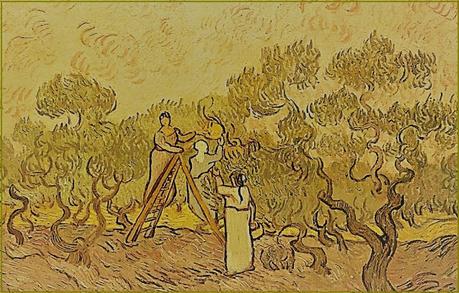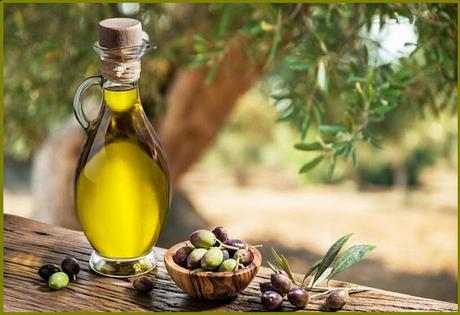There are myths associated with the olive in several cultures. Possibly the most famous is the ancient Greek tale of the sacred moria (Οο�ίιΚ). Legend has it that when King Cecrops founded the city of Attica, he wanted to appoint a deity to be its patron and protector. Athena and Poseidon both wished the honor to be theirs, so a contest was agreed upon. Whichever of the two Olympians could promise to bestow the more useful gift upon the people of Attica, that one would be appointed and revered as the patron of the city.
Poseidon struck a rock with his trident and spring of salt water burst forth. Next, Athena thrust her spear into the ground of the Acropolis, then knelt down and planted an olive branch in the hole. This quickly grew into Greece's first moria, or olive tree. The king and people of Attica debated and concluded that salt water was not of much use, whereas the olive would have multiple uses. Thus Athena's precious gift won the contest. She was appointed as goddess and protector of the new city and the grateful citizens renamed it Athens in her honor.

olive harvesting (after Van Gogh)
What is more, because it was a divine gift, the olive tree became regarded as property of the state (whether it grew on public or private land). Olive groves were visited monthly by inspectors and yearly by a commissioner to ensure their well-being and to uproot an olive tree was a punishable offense.The olive tree has been central to Greek life and culture for millennia. Apart from olives and olive oil being a staple of the Mediterranean diet, the oil was also used to fuel lamps, as a balm and cosmetic. Olive wood was used in the construction of houses, boats and artefacts. Even the leaves were employed in wreaths to crown the heads of victorious athletes, generals and kings.
I'm biased in thinking that Greek olives are the finest in the world. By volume, it is only the fifth biggest producer (behind Spain, Italy, Morocco and Turkey) but it appears to have a more diverse range of cultivars than the other countries, maybe because it was the original cradle of olive cultivation - the oldest mention is from Mycenaean times in proto-Greek Linear B script. Most people have become familiar with Kalamata olives, but that's only one of fifteen different varieties grown in the olive groves of Greece. I won't list them, though they all have wonderful names. It may be worth just mentioning Athenolia - as that could be the very strain that Athena is supposed to have presented to the citizens of Attica. And I do have a favorite. It's the Tsounati olive from dusty Crete.
Olives are harvested between August and November and are still picked by hand in many areas although machines to vibrate the branches are becoming more widely used on big commercial plantations. As mentioned at the outset, the color varies depending on the degree of ripeness. All olives start out green and if left will progress through rose to purple to black. Pick early for green and late for black. The fruit can be enjoyed fresh with salads, but can also be stuffed, pickled or added to cooked dishes. (I actually use olives in quite a lot of recipes.). When pressed, the flesh yields up olive oil, an unsaturated fat used in cooking, cosmetics and medicine. Not surprisingly, Greece is the biggest consumer of both olives and olive oil.

produce of the olive tree
Over the years I've bought many lovely items made out of olive wood, mostly as presents for friends and family. For personal use I have a beautiful olive wood bowl and a set of wooden worry beads. I love the grain and the feel.Girl From The Gift ShopWe were talking about the beauty of olive woodand she accepted my offer of a beer after hours.In a bar across the street she enthused over foodabout the myth of Athena and the olive tree, hadthe waiter bring us a bowl of Athenoli to sampleand bewitched with tales of those ancient groves.
Once city streets fell quietly to sleep, I dreamed.Inspirited, she explained. Midnight, she insisted.Everything seemed quite different by moonlight,primal, poised as in a frieze, the trees and I bothrooted. You'll feel overlooked, she said, sized upbut please don't be afraid to embrace the mystery.
I haven't words to relay what I observed, sensedrather than saw in the sacred grove. Some dancemaybe, transformative, entrancing, pulled me in to a ravishing ritual celebration of eternal unity.I must have said tell me your name. In a whispershe replied: I have so many: Dryad, Elia, Moria.
Bright sunlight woke me late and after coffee Ireturned to the gift shop, made some purchasesand small talk as she parcelled up my presents.When I asked her for her name she smiled shyly,replied: you may call me Dryad, Elia or Moria...not unlike silvered leaves fluttering in the breeze.
Thanks for reading, S ;-) Email ThisBlogThis!Share to TwitterShare to Facebook
